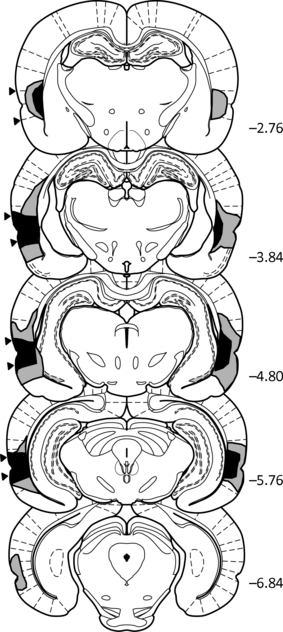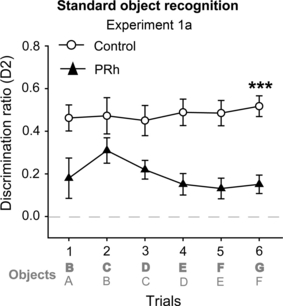Perirhinal cortex lesions uncover subsidiary systems in the rat for the detection of novel and familiar objects
- PMID: 21707792
- PMCID: PMC3170480
- DOI: 10.1111/j.1460-9568.2011.07755.x
Perirhinal cortex lesions uncover subsidiary systems in the rat for the detection of novel and familiar objects
Abstract
The present study compared the impact of perirhinal cortex lesions on tests of object recognition. Object recognition was tested directly by looking at the preferential exploration of novel objects over simultaneously presented familiar objects. Object recognition was also tested indirectly by presenting just novel objects or just familiar objects, and recording exploration levels. Rats with perirhinal cortex lesions were severely impaired at discriminating a novel object from a simultaneously presented familiar object (direct test), yet displayed normal levels of exploration to novel objects presented on their own and showed normal declines in exploration times for familiar objects that were repeatedly presented (indirect tests). This effective reduction in the exploration of familiar objects after perirhinal cortex lesions points to the sparing of some recognition mechanisms. This possibility led us to determine whether rats with perirhinal cortex lesions can overcome their preferential exploration deficits when given multiple object familiarisation trials prior to that same (familiar) object being paired with a novel object. It was found that after multiple familiarisation trials, objects could now successfully be recognised as familiar by rats with perirhinal cortex lesions, both following a 90-min delay (the longest delay tested) and when object recognition was tested in the dark after familiarisation trials in the light. These latter findings reveal: (i) the presumed recruitment of other regions to solve recognition memory problems in the absence of perirhinal cortex tissue; and (ii) that these additional recognition mechanisms require more familiarisation trials than perirhinal-based recognition mechanisms.
© 2011 The Authors. European Journal of Neuroscience © 2011 Federation of European Neuroscience Societies and Blackwell Publishing Ltd.
Figures








References
-
- Aggleton JP, Brown MW. Episodic memory, amnesia and the hippocampal – anterior thalamic axis. Behav. Brain Sci. 1999;22:425–444. - PubMed
-
- Aggleton JP, Keen S, Warburton EC, Bussey TJ. Extensive cytotoxic lesions of the rhinal cortices impair recognition but spare spatial alternation in the rat. Brain Res. Bull. 1997;43:279–287. - PubMed
-
- Albasser MM, Davies M, Futter JE, Aggleton JP. Magnitude of the object recognition deficit associated with perirhinal cortex damage in rats: effects of varying the lesion extent and the duration of the sample period. Behav. Neurosci. 2009;123:115–124. - PubMed
Publication types
MeSH terms
Grants and funding
LinkOut - more resources
Full Text Sources

